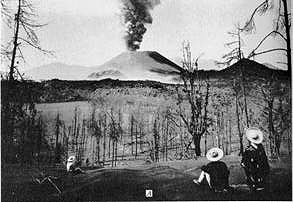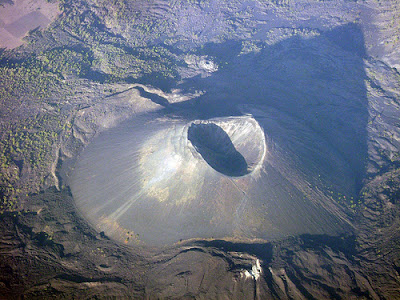Mount Paricutin is one of the most amazing wonders of Mother Nature, a volcano grown out of a cornfield. The cornfield volcano is the youngest volcano in the Western Hemisphere and one of the '7' Wonders of the World.
Mount Paricutin
 |
| Paricutin erupting at night, 1948 |
The Paricutin is the world's only volcano whose birth has been witnessed by human eyes. It is one of the youngest volcanoes and its bizarre story has made it to the 7 wonders of the world. Paricutin grew out of a Mexican cornfield. Its birth, although wasn't as disastrous as the fall of Pompeii, nonetheless represents a dramatic period in the lives of the inhabitants of Paricutin, Mexico.
The Story
 |
| Paricutin, 1944 |
The story takes place in Paricutin, a small Mexican village of farmers. It is situated in an active tectonic area. It was a usual Saturday afternoon. Farmer
Dionisio Pulido was working in the field, with his wife preparing dinner for the family, much like she did everyday. Unaware of the fact, that the day would become one of the most infamous days of human history.
Suddenly, Dionisio felt strong tremors and thunder sounds from the ground. He couldn't believe his eyes, when he saw the ground crack open. Soon, a pungent odour spread in the field. The odour of burning sulphur. Dionisio's wife rushed outside and the couple became the first human ever to witness the birth of a volcano.
The Development
Soon after, lava and ash started flowing out of the fissure, affecting Paricutin and other nearby villages. The ashes from the volcano fell as far as the Mexico city. The volcano grew rapidly from a fissure to a height of a 5-storey building in no more than a week.Paricutin Volcano Facts
- Location: Mexico
- Eruption: 1943 to 1952
- Area Covered: 25 sq. km
- Total Height: 1345 feet
- Major Eruption: 1943
- Characteristic: Youngest volcano in Western Hemisphere
Paricutin erupted frequently during the first few months of its birth. Most of the volcano's growth occurred in the first year. At the end of the first year, the Paricutin had reached a massive height of 1,102 feet.
The Paricutin continued erupting between 1943 and 1952, affecting hundreds of thousands of lives. During this period, lava and ash swept an area of more than 25 sq. km. The worst of Paricutin's volcanic activity, took place in 1943, with its lava rising to about 50 feet below the crater's rim and killing more than 1000 inhabitants.
The Death
Paricutin is a
Monogenetic Volcano, meaning that once it has finished erupting, it will never erupt again. The last of the eruptions occurred in 1952, after which the Paricutin calmed. It has been quite since then, reaching a final height of 1,345 feet.



Tidak ada komentar:
Posting Komentar